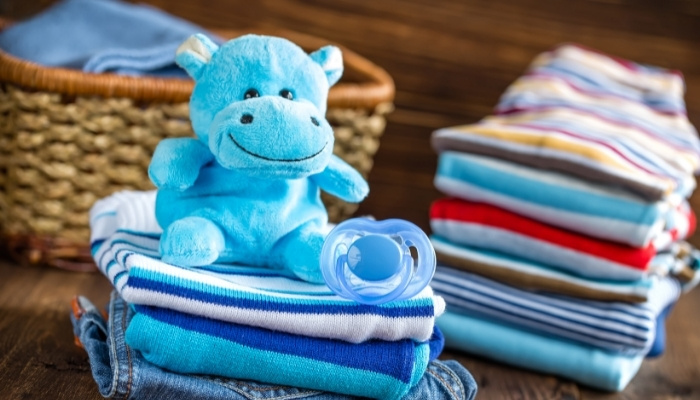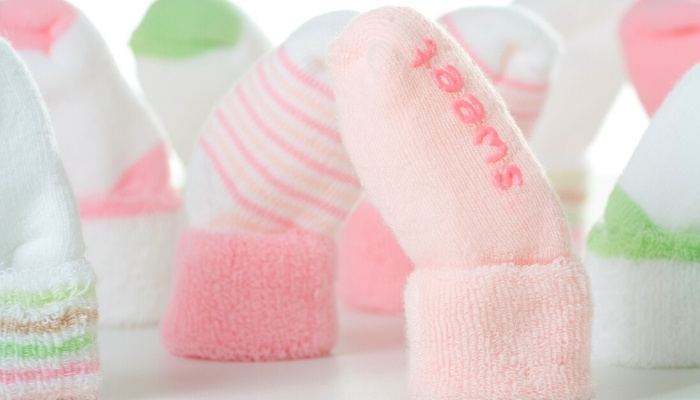Upon the arrival of a newborn, parents typically aim to have all necessary items on hand as babies require a lot of essentials.
Socks are sometimes the unsung heroes in the wardrobe department for babies as they aren’t necessarily as fun as buying cute onesies. They do, however, serve a purpose.
How many baby socks do I need? Most sources recommend that you have five pairs of socks for a new baby. If you live in a colder climate, add two extra pairs of socks to your registry. For those whose house is always warm and who live in a warm climate, socks may not be necessary at all.
The exact quantity of baby socks you need depends on how many times a week you plan to do laundry.
Babies change just about every facet of life, so laundry might not get done as often as originally planned, which could affect how many you need.
Read on to learn everything you need to know about baby socks and how to be best prepared.
Baby Socks
Few things are cuter than tiny feet in cute little socks. Socks on babies’ feet are also an important part of helping keep your baby comfortable and protected.
Benefits of Baby Socks
Socks help your baby regulate body temperature. Babies have a harder time knowing how to regulate their internal temperature, and keeping their feet warm aids in that.
Babies born early or at a low birth rate benefit most from warm socks on their feet. Socks also offer protection both from the elements and injury when they become more mobile.
Another benefit of baby socks is that they keep babies’ feet warm outside. If taking your baby outside, I recommend bringing one to two pairs of socks in the diaper bag as socks get kicked off often.
No Socks on Babies
There is no mandatory rule that says a baby must have with their feet covered. Many parents who live in warm climates or without air conditioning opt to keep their baby’s feet uncovered.
Research has disproved the idea that a baby will catch a cold if their feet are cold as a virus cannot pass through the feet.
A more accurate assumption is that a baby with cold extremities might not regulate their body temperature well and have a harder time fighting off illness.
Baby Sock Sizes
Baby socks come in similar sizes to infant clothes. The sizes are usually in 3-month groupings for the first year and then 6-month groupings for older toddlers.
Number of Baby Socks You’ll Need
If you think you are going to be able to do laundry at least two times a week, you only need to get about five pairs of socks. If you live in a colder climate, it’s recommended that you add a couple more pairs to your registry.
What To Look For
The most important thing you want to look for with baby socks is that they are made with breathable material. Feet contain a lot of sweat glands, and certain materials are better at wicking the moisture away rather than just absorbing it.
Parents also want to be cautious of things such as seams that might make socks uncomfortable for the baby.
Are Second-Hand Socks Okay For Baby?
While there are a few things that should be bought new for each baby, such as a car seat or a crib, socks are an item that is perfectly okay to buy second-hand. In fact, most clothing for babies is okay to be passed down to other babies.

Best Baby Socks
Parents often have brand loyalty when it comes to clothing for their babies. Once a parent finds something that might make life a bit easier, they tend to tell other parents as well.
Little Me 20-Pack Baby Socks 2 Sizes
One brand of socks that parents rate highly is from the Little Me Store. These socks come in packs of 20 with two different size groupings of 0-12 months and 12-24 months.
They run about $12 for a 20-pack. Another nice feature is that all the socks are white, so there is no inevitable mismatching of socks.
Burts Bees Organic Cotton Baby Socks
These socks come in three different size groupings and also have a nonslip grip on the bottom for babies.
This nonslip feature could be great for when babies are becoming more mobile and safety is a bigger concern. These socks come in a 6-pack and in coordinating colors.
Burts Bees Organic Cotton Booties
A different option is a bootie for your baby. Booties offer a better fit that can be adjusted as a baby grows. These Burts Bees booties wrap around the ankle for a more secure fit.
They come in three different size groupings and can grow with your baby by adjusting the ankle part.
Babies Clothes Checklist 0-3 Months
Buying baby clothing could be one of the most fun parts of expecting a child. Below is a list of what you might need and how much of each in the first 0-3 months of your baby’s life.
Of course, if you anticipate that you won’t be doing laundry often, you’ll want to purchase more.
| Baby Clothing (0-3 Months) | Approximate # Needed |
| Onesies | 5-8 |
| Sleepers or sleep sacks | 3-4 |
| Baby socks | 5-7 |
| hats | 1-2 |
| Pants | 3-4 |
How To Organize Baby Clothes

Organizing baby clothes can make your life so much easier. When baby has had a blowout and you’re desperate to change them, knowing exactly where their clothes are located makes for smoother transitions.
Grouping
Putting like items together, such as long sleeve onesies in one drawer and short sleeves in another, is one method to organize tiny baby clothes. Pants can go in one drawer, sleepers in another, towels and blankets in another, and on it goes.
By Size
It is recommended that you buy clothes in various sizes so that you’re ready when your baby suddenly outgrows clothing. Group clothes in drawers or in small containers by the size grouping such as Newborn, 0-3, 3-6, and so forth.
Seasonal Clothes
Seasonal clothes for babies should be stored in a separate area if possible.
This helps to avoid pulling clothes out for the day that aren’t appropriate for the current weather. It also helps keep only clothes that you need at that moment in the right place.
Drawer Organizer
Drawer organizers are a lifesaver with tiny baby clothes. I put them in the drawers for my twins and then went and bought the same ones for my husband and me.
The drawer organizer helps keeps things from shifting and allows you to group things together easily without having to use up all your drawers.
Dresser vs. Closet
Where you store your baby’s clothes is entirely up to you and what is available to you in your living situation.
A dresser often seems easier to keep organized and allows you to fit more inside. Closets are a good choice if you don’t like clothes getting wrinkled.
Additional Tips
The biggest tip I can give to new parents is to not overbuy as you might not know what size your baby needs until after they are born.
The other important advice I like to give new parents is to do as much as you can to create systems and have them in place before the baby arrives. It’s a wild ride when baby gets there, and systems can help mitigate the chaos.
Related Questions:
Are Baby Socks One Size Fits All?
Baby socks are not one size fits all. They come in different size groupings based on the age of your baby, though these size groupings are usually just suggestions.
Do Newborns Need Socks in the Winter?
Newborn babies have a hard time regulating their body temperature. Socks can help keep babies warm and are recommended even in the summer.
If your infant’s feet feel cold to the touch, the safest choice would be to put them in socks.
Conclusion
Socks are not a mandatory item for your baby. Most parents, especially new parents, err on the side of caution and put their babies in socks.
The climate where you live and how often you plan to do laundry dictate how many pairs of socks you might need. There are not many things cuter than little bitty toes in tiny socks, so getting them simply for the aesthetic might be worth it alone.
Mom of three (including identical twin boys), wife, and owner of Parents Wonder. This is my place to share my journey as a mother and the helpful insights I learn along the way.

